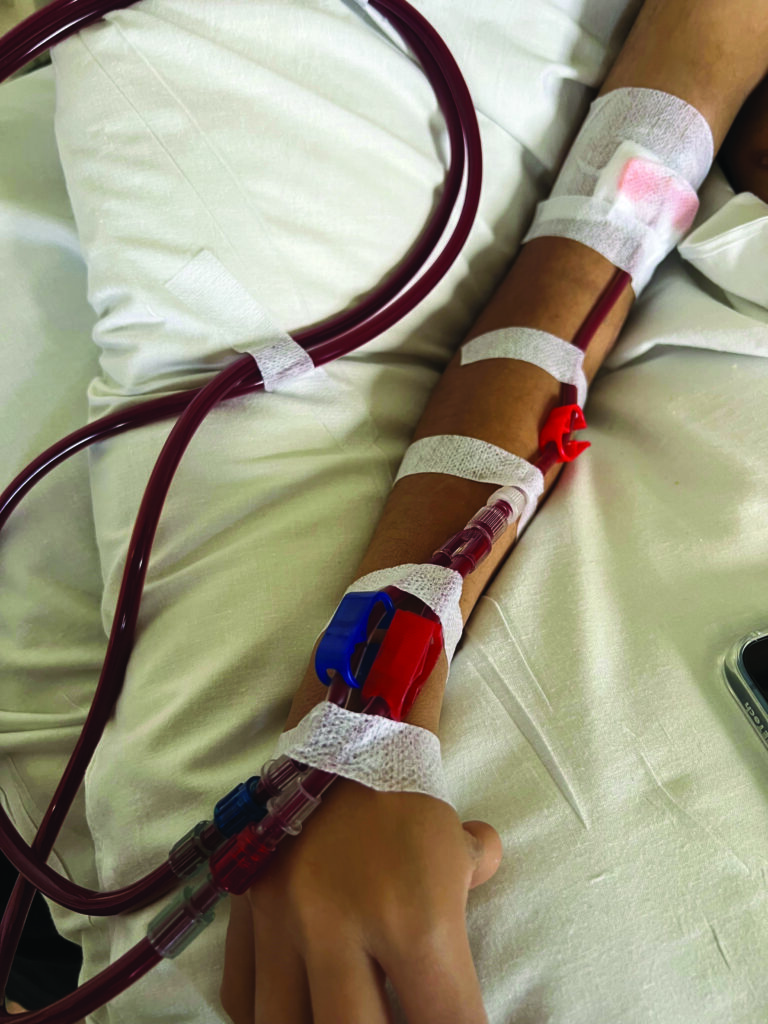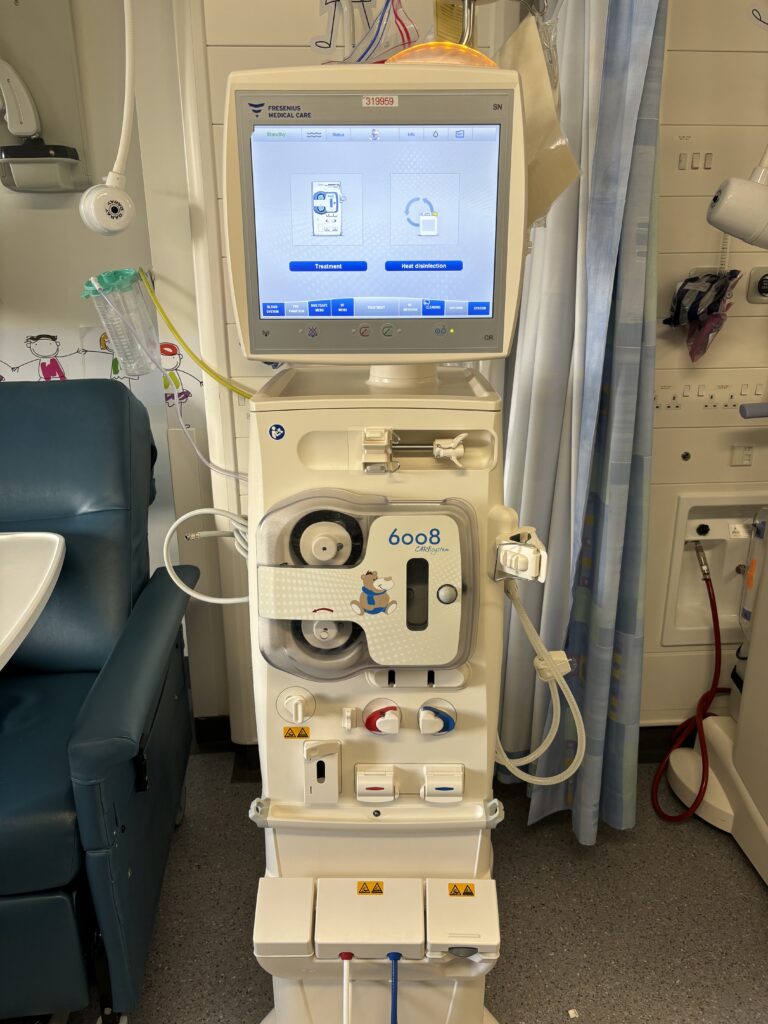You have been given this leaflet as your (or your child’s) kidneys are now working at a very low level.
We need to support the kidneys with a treatment called dialysis.
What is dialysis?
The kidney has many jobs but it’s main job is to ‘clean rubbish/waste’ from the blood and to remove extra water from the body. When the kidneys are not working properly, the rubbish/waste and water collect in the body and this makes you feel poorly. Dialysis is a treatment that helps the kidneys by removing water and rubbish/waste from the body.
Dialysis is usually used as a treatment until a kidney transplant is possible. How long the dialysis treatment will be needed will vary from person to person.
What types of dialysis are there?
There are two main types of dialysis:
Haemodialysis (He-mo-dye-a-lee-sis) or HD: This is a treatment that can be performed in hospital or at home. To have haemodialysis you need an operation to put a haemodialysis tube (catheter) into the side of the neck. Sometimes you can have an operation to have a fistula (which is where two blood vessels in the arm are joined under the skin) instead of a haemodialysis tube.
A dialysis machine is connected to the haemodialysis tube or to needles put into the fistula. The machine then removes blood from the body, cleans it and removes water and then the blood is given back. This does not hurt.




Peritoneal dialysis (Pe-ri-toe-neil dye-a-lee-sis) or PD: This treatment is done at home usually overnight. For this type of dialysis you need an operation to put in a different type of dialysis tube called a PD catheter. This tube goes into the tummy.
Whilst you sleep at night time, a dialysis machine is connected to the PD tube and a small amount of fluid is pumped around your tummy. This is left for about an hour and during this time the rubbish/waste and extra water gradually mix with the fluid and then everything is pumped out by the dialysis machine.
This happens again and again over night during sleep. This does not hurt. By the morning lots of the waste products and water have been removed and the dialysis machine can be carefully removed from the PD tube.


How do we decide which type of dialysis is the
right one?
There is no right type of dialysis – it is more important that the chosen type suits you and your family the best. With help from the children’s nephrology team, a shared decision will be made. Each type of dialysis has different good points and bad points.
Sometimes one of the types of dialysis may not be right for you. If this is the case the children’s nephrology team will tell you. Once you have had time to think about the different dialysis treatments, we will provide you with more information. If you have any questions, please ask the children’s nephrology team
Quick Guide to Dialysis Types
Hospital Haemodialysis (HD)
What will I need to have dialysis
- A dialysis catheter ‘tube’ (picture A) or a fistula (picture B).
How often do I need it?
- Daytime treatment. 3-4 times per week.
- 3-4 hours each session (plus travelling time).
What restrictions will there be?
- Contact sports and swimming (with catheter/tube).
How long will I need to stay in hospital?
- 1-2 nights to have catheter/tube put in or fistula formed.
- Attendance to hospital for each dialysis session.
Who does the dialysis?
- Dialysis nurses.
What training is needed?
- No training requirement.
Will school have be missed?
- Yes – when travelling to and attending dialysis.
- Hospital teachers are available during HD sessions.
What are the common side effects/risks?
- Vomiting, headache, tiredness, leg pains.
- Line infection (if dialysis catheter present), fistula infection/bleeding (if fistula present).
Home Haemodialysis (HHD)
What will I need to have dialysis
- A dialysis catheter ‘tube’ (picture A) or a fistula (picture B).
How often do I need it?
- Daytime/Evening treatment. 3-5 times per week.
- 3-5 hours each session.
What restrictions will there be?
- Contact sports and swimming (with catheter/tube).
How long will I need to stay in hospital?
- 1-2 nights to have catheter/tube put in or fistula formed.
- Once training complete, clinic once every 4 weeks.
Who does the dialysis?
- Parent/carer or young person.
What training is needed?
- Technical to learn.
- Training to perform dialysis will take a number of weeks.
Will school have be missed?
- No.
What are the common side effects/risks?
- Vomiting, headache, tiredness, leg pains. (These are less common than with hospital HD).
- Line infection (if dialysis catheter present), fistula infection/bleeding (if fistula present).
Peritoneal Dialysis (PD) at home
What will I need to have dialysis
- A peritoneal dialysis ‘PD’ catheter seen in picture E.
How often do I need it?
- Overnight treatment.
- 6-7 nights per week. 8-12 hours each session.
What restrictions will there be?
- Contact sports.
- Swimming (for the first 6 weeks after insertion).
How long will I need to stay in hospital?
- 1-2 nights to have the PD catheter put in.
- 1-2 nights once starting on PD (usually 2 weeks later).
- Clinic once every 4 weeks once established on dialysis.
Who does the dialysis?
- Parent/carer or young person.
What training is needed?
- Training to perform dialysis usually takes 2-3 weeks.
- Easier to learn.
Will school have be missed?
- No.
What are the common side effects/risks?
- Infection (around the tube: ‘exit site infection’ or within the abdomen ‘peritonitis’), poor appetite, abdominal pain (when starting PD-usually temporary), hernia, testicular swelling (known as hydrocele).
Further information
Useful Websites
infoKid – YouTube video
What is renal replacement therapy?
Renal is the word used to describe anything to do with the kidney. Your kidneys have an important job in keeping you healthy; they do lots of jobs; they clean your blood by removing waste; extra salt and water help control your blood pressure. Tell your body to make new red cells to carry oxygen in your blood and keep your bones healthy when they are no longer able to do their job. You have end-stage kidney disease. You might not notice any change in how you feel until this point. Your kidney team will talk to you about ways to replace the work your kidneys do to keep you healthy. This is called renal or kidney replacement therapy. The two main treatments you can have are a kidney transplant or dialysis.
Let’s start with a kidney transplant. A kidney transplant is a big operation where a kidney is taken from someone called a donor and placed into your body. This new kidney can do all the jobs your old kidneys couldn’t. You’ll need to take good care of it by taking medicines every day, drinking lots, and keeping healthy to help your new kidney work well. Children who need it will be prepared for a kidney transplant because it is the best way of keeping you healthy. So how would you get this new kidney? The donor can either be a living person or a deceased person who recently died. It was a choice made before they died. Lots of people do this. An adult relative or friend may choose to be a living donor. They can give away one kidney, as they only need one to stay healthy. They have to have tests to see if they match you well and are healthy enough. These tests can take several months.
Sometimes you don’t have a match in your family. That’s okay. There’s a kidney sharing scheme where other people like you with their healthy donors who don’t match each other can swap kidneys with other pairs. How cool is it that sometimes a stranger who wants to do a good thing decides to donate one of their kidneys? This is called an altruistic kidney transplant. If you don’t have a donor, you will go on a waiting list to get a match to have a deceased owner transplant. This is when a kidney match is taken from a person who recently died who has agreed to give it away.
Sometimes this happens quickly, but more often you will wait a few years for a match. Dialysis while waiting for a transplant, Your kidney team may talk to you about dialysis, where machines do the job of your kidneys by cleaning your blood of waste, extra water, and salt. There are two types. Haemodialysis and personal dialysis With haemodialysis, you are connected to a machine that does the job of your kidney through a special line or fistula. To have a fistula, you will need surgery several months before to connect the vessels in your arm; whichever you have, blood is pumped into the machine to be cleaned and then returned to you. This takes around 3 to 4 hours each time in the hospital.
Most people will do this three to four times a week, and some will learn to do this at home with paranal dialysis. You were connected to a different machine through a tube inserted through your tummy. Here, a special fluid fills the space in your tummy, touching the inside lining called the peritoneum, and let’s waste come out of it, which is then drained away. This happens every night, usually when you are asleep. Your family will be taught how to set this up at home. Which type you’ll have if you need it depends on several factors that your kidney team will discuss with you. Remember, dialysis is only one part of your treatment. You also need to watch what you eat and drink and take your medication and injections to keep you healthy. We hope that you have found this helpful.